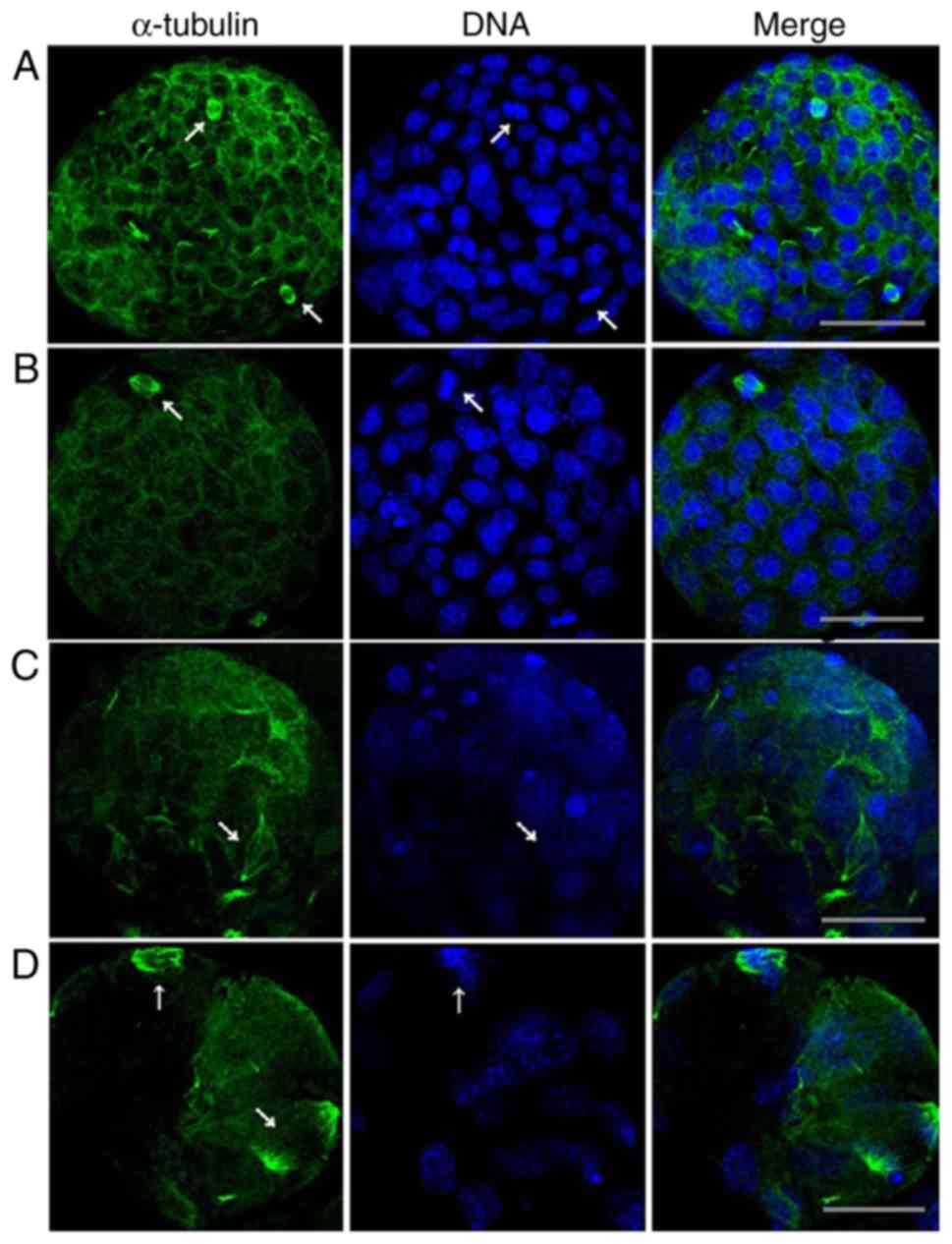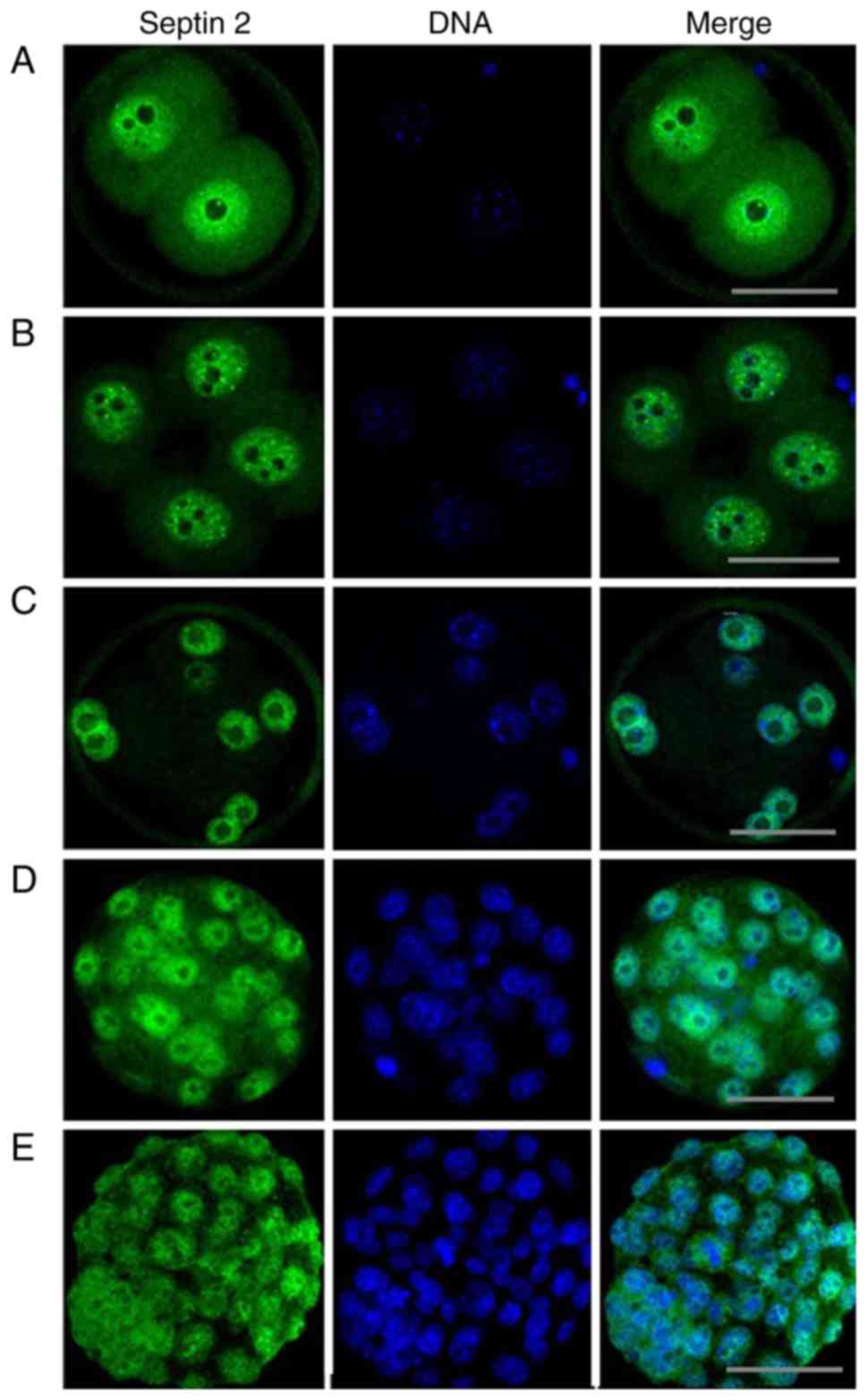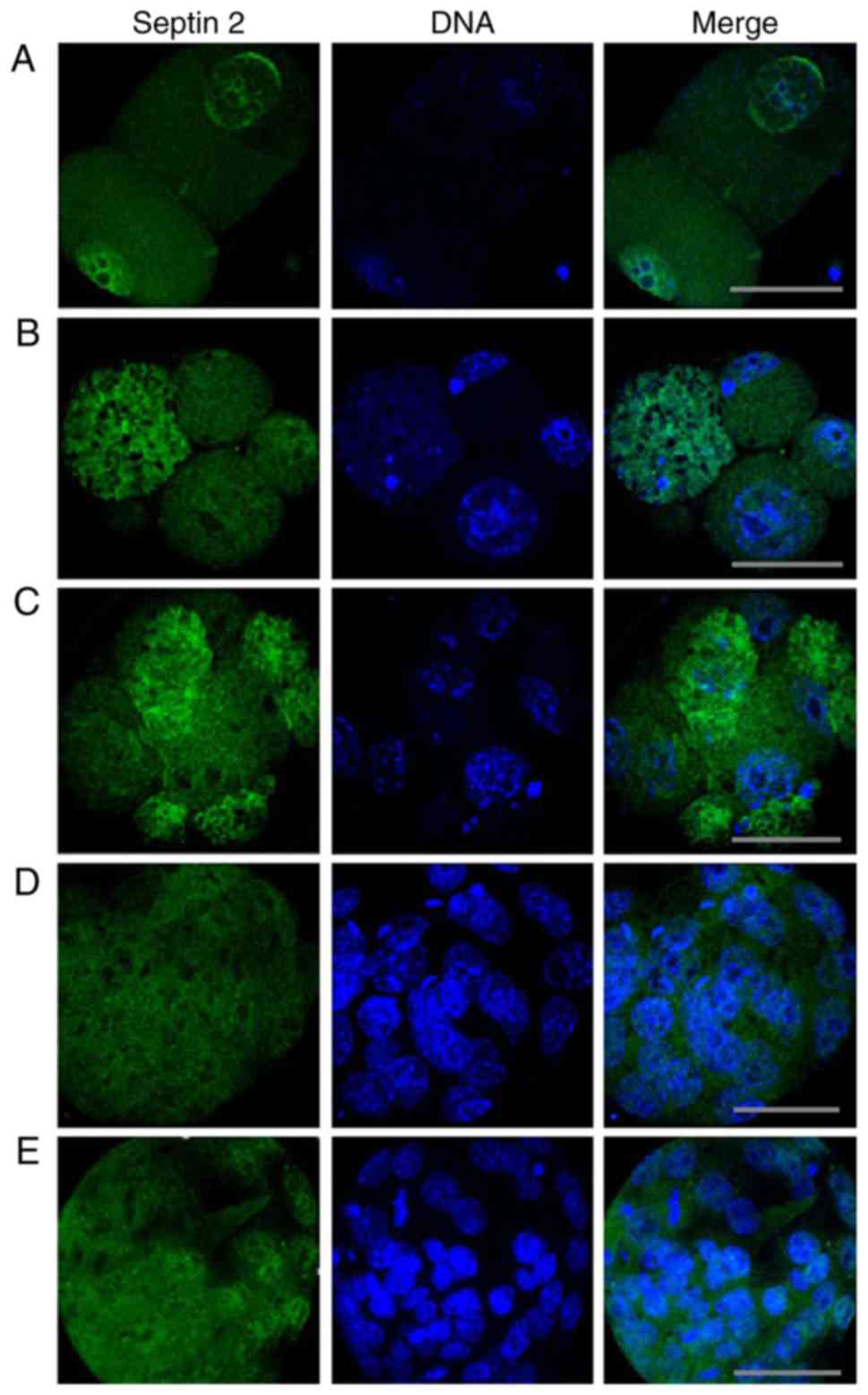|
1
|
Macklon NS, Geraedts JP and Fauser BC:
Conception to ongoing pregnancy: The ‘black box’ of early pregnancy
loss. Hum Reprod Update. 8:333–343. 2002. View Article : Google Scholar : PubMed/NCBI
|
|
2
|
Lim JH, Kim MH, Han YJ, Lee DE, Park SY,
Han JY, Kim MY and Ryu HM: Cell-free fetal DNA and cell-free total
DNA levels in spontaneous abortion with fetal chromosomal
aneuploidy. PLoS One. 8:e567872013. View Article : Google Scholar : PubMed/NCBI
|
|
3
|
Vullaire L, Collins V, Callaghan T, McBain
J, Williamson R and Wilton L: High incidence of complex chromosome
abnormality in cleavage embryos from patients with repeated
implantation failure. Fertil Sterii. 87:1053–1058. 2007. View Article : Google Scholar
|
|
4
|
Capalbo A, Bono S, Spizzichino L, Biricik
A, Baldi M, Colamaria S, Ubaldi FM, Rienzi L and Fiorentino F:
Sequential comprehensive chromosome analysis on polar bodies,
blastomeres and trophoblast: Insights into female meiotic errors
and chromosomal segregation in the preimplantation window of embryo
development. Hum Reprod. 28:509–518. 2013. View Article : Google Scholar : PubMed/NCBI
|
|
5
|
Hartwell LH: Genetic control of the cell
division cycle in yeast. IV. Genes controlling bud emergence and
cytokinesis. Exp Cell Res. 69:265–276. 1971. View Article : Google Scholar : PubMed/NCBI
|
|
6
|
Kinoshita M: Assembly of mammalian
septins. J Biochem. 134:491–496. 2003. View Article : Google Scholar : PubMed/NCBI
|
|
7
|
Hall PA, Todd CB, Hyland PL, McDade SS,
Grabsch H, Dattani M, Hillan KJ and Russell SE: The septin-binding
protein anillin is overexpressed in diverse human tumors. Clin
Cancer Res. 11:6780–6786. 2005. View Article : Google Scholar : PubMed/NCBI
|
|
8
|
Cao L, Ding X, Yu W, Yang X, Shen S and Yu
L: Phylogenetic and evolutionary analysis of the septin protein
family in metazoan. FEBS Lett. 581:5526–5536. 2007. View Article : Google Scholar : PubMed/NCBI
|
|
9
|
Mostowy S and Cossart P: Septins: The
fourth component of thecytoskeleton. Nat Rev Mol Cell Biol.
13:183–194. 2012. View
Article : Google Scholar : PubMed/NCBI
|
|
10
|
Gladfelter AS, Pringle JR and Lew DJ: The
septin cortex at the yeast mother-bud neck. Curr Opin Microbiol.
4:681–685. 2001. View Article : Google Scholar : PubMed/NCBI
|
|
11
|
Spiliotis ET and Nelson WJ: Here come the
septins: novel polymers that coordinate intracellular functions and
organization. J Cell Sci. 119:4–10. 2006. View Article : Google Scholar : PubMed/NCBI
|
|
12
|
Zhu JL, Lin SL, Li M, Ouyang YC, Hou Y,
Schatten H and Sun QY: Septin2 is modified by SUMOylation and
required for chromosome congression in mouse oocytes. Cell Cycle.
9:1607–1616. 2010. View Article : Google Scholar : PubMed/NCBI
|
|
13
|
Zhu J, Qi ST, Wang YP, Wang ZB, Ouyang YC,
Hou Y, Schatten H and Sun QY: Septin1 is required for spindle
assembly and chromosome congression in mouse oocytes. Dev Dyn.
240:2281–2289. 2011. View Article : Google Scholar : PubMed/NCBI
|
|
14
|
Li S, Ou XH, Wei L, Wang ZB, Zhang QH,
Ouyang YC, Hou Y, Schatten H and Sun QY: Septin 7 is required for
orderly meiosis in mouse oocytes. Cell Cycle. 11:3211–3218. 2012.
View Article : Google Scholar : PubMed/NCBI
|
|
15
|
Kopecný D, Briozzo P, Popelková H, Sebela
M, Koncitíková R, Spíchal L, Nisler J, Madzak C, Frébort I, Laloue
M and Houba-Hérin N: Phenyl- and benzylurea cytokinins as
competitive inhibitors of cytokinin oxidase/dehydrogenase: A
structural study. Biochimie. 92:1052–11062. 2010. View Article : Google Scholar : PubMed/NCBI
|
|
16
|
Heasley LR and McMurray MA: Small molecule
perturbations of septins. Methods Cell Biol. 136:311–319. 2016.
View Article : Google Scholar : PubMed/NCBI
|
|
17
|
Iwase M, Okada S, Oguchi T and Toh-e A:
Forchlorfenuron, a phenylurea cytokinin, disturbs septin
organization in Saccharomyces cerevisiae. Genes Genet Syst.
79:199–206. 2004. View Article : Google Scholar : PubMed/NCBI
|
|
18
|
Hu Q, Nelson WJ and Spiliotis ET:
Forchlorfenuron alters mammalian septin assembly, organization, and
dynamics. J Biol Chem. 283:29563–29571. 2008. View Article : Google Scholar : PubMed/NCBI
|
|
19
|
Zhu JL: Septin1/2 are required for meiotic
spindle assembly and chromosome congression in mouse oocytes. Chin
Acad Sci. 2011.(In Chinese).
|
|
20
|
Reddy SK, Rape M, Margansky WA and
Kirschner MW: Ubiquitination by the anaphase-promoting complex
drives spindle checkpoint inactivation. Nature. 446:921–925. 2007.
View Article : Google Scholar : PubMed/NCBI
|
|
21
|
Spiliotis ET, Hunt SJ, Hu Q, Kinoshita M
and Nelson WJ: Epithelial polarity requires septin coupling of
vesicle transport to polyglutamylated microtubules. J Cell Biol.
180:295–303. 2008. View Article : Google Scholar : PubMed/NCBI
|
|
22
|
Spiliotis ET, Kinoshita M and Nelson WJ: A
mitotic septin scaffold required for Mammalian chromosome
congression and segregation. Science. 307:1781–1785. 2005.
View Article : Google Scholar : PubMed/NCBI
|
|
23
|
Cleveland DW, Mao Y and Sullivan KF:
Centromeres and kinetochores: From epigenetics to mitotic
checkpoint signaling. Cell. 112:407–421. 2003. View Article : Google Scholar : PubMed/NCBI
|
|
24
|
Vallen EA, Caviston J and Bi E: Roles of
Hof1p, Bni1p, Bnr1p, and myo1p in cytokinesis in Saccharomyces
cerevisiae. Mol Biol Cell. 11:593–611. 2000. View Article : Google Scholar : PubMed/NCBI
|
|
25
|
Finger FP, Kopish KR and White JG: A role
for septins in cellular and axonal migration in C. elegans. Dev
Biol. 261:220–234. 2003. View Article : Google Scholar : PubMed/NCBI
|
|
26
|
Sitz JH, Baumgärtel K, Hämmerle B,
Papadopoulos C, Hekerman P, Tejedor FJ, Becker W and Lutz B: The
Down syndrome candidate dual-specificity tyrosine
phosphorylation-regulated kinase 1A phosphorylates the
neurodegeneration-related septin 4. Neuroscience. 157:596–605.
2008. View Article : Google Scholar : PubMed/NCBI
|
|
27
|
Tanaka TU and Desai A:
Kinetochore-microtubule interactions: The means to the end. Curr
Opin Cell Biol. 20:53–63. 2008. View Article : Google Scholar : PubMed/NCBI
|
|
28
|
Powers AF, Franck AD, Gestaut DR, Cooper
J, Gracyzk B, Wei RR, Wordeman L, Davis TN and Asbury CL: The Ndc80
kinetochore complex forms load-bearing attachments to dynamic
microtubule tips via biased diffusion. Cell. 136:865–875. 2009.
View Article : Google Scholar : PubMed/NCBI
|
|
29
|
Angelis D and Spiliotis ET: Septin
mutations in human cancers. Front Cell Dev Biol. 4:1222016.
View Article : Google Scholar : PubMed/NCBI
|
|
30
|
Kissel H, Georgescu MM, Larisch S, Manova
K, Hunnicutt GR and Steller H: The Sept4 septin locus is required
for sperm terminal differentiation in mice. Dev Cell. 8:353–364.
2005. View Article : Google Scholar : PubMed/NCBI
|
|
31
|
Connolly D, Abdesselam I, Verdier-Pinard P
and Montagna C: Septin roles in tumorigenesis. Biol Chem.
392:725–738. 2011. View Article : Google Scholar : PubMed/NCBI
|
|
32
|
Scott M, Hyland PL, McGregor G, Hillan KJ,
Russell SE and Hall PA: Multimodality expression profiling shows
SEPT9 to be overexpressed in a wide range of human tumours.
Oncogene. 24:4688–4700. 2005. View Article : Google Scholar : PubMed/NCBI
|
|
33
|
Stanbery L, D'Silva NJ, Lee JS, Bradford
CR, Carey TE, Prince ME, Wolf GT, Worden FP, Cordell KG and Petty
EM: High SEPT9_v1 expression is associated with poor clinical
outcomes in head and neck squamous cell carcinoma. Transl Oncol.
3:239–245. 2010. View Article : Google Scholar : PubMed/NCBI
|
|
34
|
Cortez BA, Rezende-Teixeira P, Redick S,
Doxsey S and Machado-Santelli GM: Multipolar mitosis and aneuploidy
after chrysotile treatment: A consequence of abscission failure and
cytokinesis regression. Oncotarget. 7:8979–8992. 2016. View Article : Google Scholar : PubMed/NCBI
|













